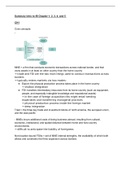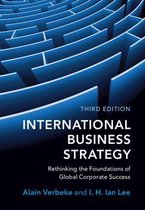Summary intro to IB Chapter 1, 2, 3, 4, and 5
CH1
Core concepts:
MNE = a firm that conducts economic transactions across national border, and that
owns assets in at least on other country than the home country
→ trade and FDI are the two main things used to conduct transactions across
borders
→ typically enters markets via two modes:
● Export: the physical production process takes place in the home country
→ shallow integration
● FDI: transfers intermediary resources from its home country (such as equipment,
people, and especially intangible knowledge and reputational assets)
→ in the case of foreign acquisition this might entail sending
expatriates and transferring managerial practices
→ physical production process inside the foreign market
→ deep integration
Triad = the three key trade and investment blocks of north america, the european union,
and the asia-pacific
- MNEs incurs additional costs of doing business abroad, resulting from cultural,
economic, institutional, and spatial distance between home and host country
environments
→ difficult to anticipate the liability of foreigness
Non-location-bound FSAs = set of MNE internal strengths, the availability of which both
allows and constrains the firms expansion across borders.
, → do not stop creating value when border is crossed (precise value may
differ)
→ costs of exploiting are relatively low, but the potential value may also be
low as it is easy to imitate
→ tacit knowledge often key source of competitive advantage abroad,
though it is expensive to transfer it is very difficult to imitate
Four types of MNEs:
● Centralized exporter = home-country managed firm sells products internationally
out of highly cost-efficient facilities in the home country. Only minor customer-
oriented, value creating activities abroad
→ standardized products
● International projector = Knowledge based FSAs developed in the home country
are transferred to foreign subsidiaries, which are clones of the home operations
● International coordinator = specialized in specific value-added activities and form
vertical value chains across borders
→ FSAs are in efficiently linking the operations through seamless
logistics
→ many MNEs in natural resources industries
● Multicentred = consists of a set of entrepreneurial subsidiaries abroad, which are
key to knowledge-based FSA development. Largely independent businesses
→ national responsiveness is the foundation
→ minimal non-location bound FSAs
Location-bound FSAs = cannot be easily transferred to foreign markers
→ four main types:
● Stand-alone resources linked to location advantages (ex. network of privileged
retail locations)
● Local marketing knowledge and reputational resources (brand names)
● Local best practices
● Domestic recombination capability
Location advantages = represent the entire set of strengths characterizing a specific
location, and usable by firms operating in that location
→ the strength depends on how effective and efficient the firms make use of
these
→ sometimes it accrues to all firms in a country (favourable tax regime)





